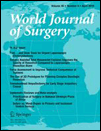Suture Versus Mesh Repair in Primary and Incisional Ventral Hernias: A Systematic Review and Meta-Analysis
Electronic supplementary material: The online version of this article (doi:10.1007/s00268-015-3311-2) contains supplementary material, which is available to authorized users.
Abstract
Background
Today, ventral hernia repair is predominantly performed with meshes. There is no meta-analysis of high quality evidence that compares the results of suture to mesh repair. The objective of this systematic review with meta-analysis is to compare patient centred outcomes of suture versus mesh repair.
Methods
A systematic literature search was performed in EMBASE, MEDLINE and CENTRAL (inception to 06/2014). Furthermore a hand search was performed. RCTs comparing suture versus mesh repair in primary and incisional ventral hernia repair were included. Data on patient characteristics, interventions and results were extracted in standardized tables. Risk of bias was assessed with the cochrane risk of bias tool. Results of studies were pooled with a meta-analysis. All steps were performed by two reviewers. Discrepancies were discussed until a consensus.
Results
The search in the databases resulted in 1560 hits. After screening, 10 randomized controlled trials including 1215 patients satisfied all inclusion criteria. Risk of bias was moderate to high. The relative risk for recurrence was 0.36 [95% CI (0.27, 0.49); I2 = 0; heterogeneity p = 0.70]. Other complications did not differ significantly. Results for chronic pain were heterogeneous across studies.
Conclusion
Mesh repair reduces the number of recurrences significantly. In patients without recurrence mesh repairs seem to be associated with a risk of chronic pain especially if the mesh is fixed sublay.




